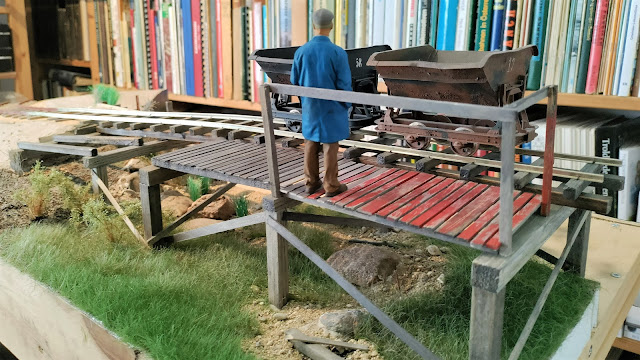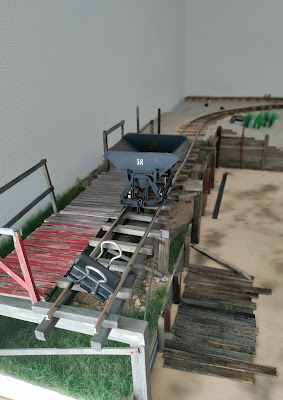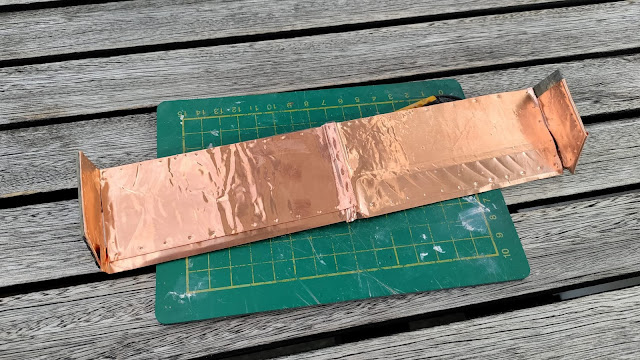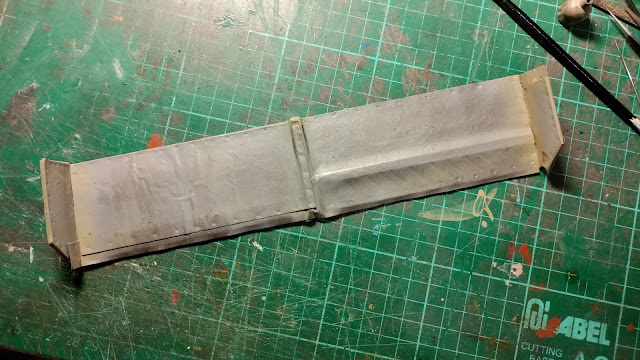The early narrow gauge diesel locomotives by John Fowler of Leeds have always fascinated me. Back when I modelled in 1:35 scale I was proud to have a Fowler diesel loco for pulling heavy trains from the gravel pits. Having changed scale and sold the loco I have been missing having a Fowler in the house. Now I have a Fowler locomotive on the layout again!
.JPG) |
| Having just arrived from the United Kingdom the new locomotive is getting a lot of attention from the employees at Nystrup Gravel. |
The loco is a Fowler F 30 in 1/19 scale built by Essel Engineering in Llanidloes, Wales. I ordered the loco in mid 2020 and while the delivery date has probably been challenged by both Covid-19, Brexit and I don't know what, I have had no problems with the production time. This is a working hand built model locomotive constructed from the wheels up with minimal use of prefinished parts. Basically a craftsman's work. It's bound to take some time. On the other hand shipping and customs took only 2 weeks which is the fastest time from the United Kingdom to Denmark I have experienced since Brexit.
.JPG) |
| The new Fowler has pushed four skips up the loading ramp. A useful locomotive! |
While I enjoy building models, I haven't all the time in the world to build nor the talent for every task. Considering how much needs to be scratch or kit built in 1:19 scale it's a luxury to be able to get a loco that is ready to run directly from the box. And yes, Nystrup Gravel is an utterly loss producing activity with not much money to spare. Fortunately the supporting structure behind the company isn't doing too bad financially.
y.jpg) |
| A charming train of skips pulled by a good looking locomotive. |
The locomotive is dimensionally a good match to the pictures available, and although I have no drawings to match the model's accuracy I feel it works out as a decent model of a Fowler F 30. The level of detail is mixed. Rivets on cab sides are clearly marked and well made. The prominent rivet and bolt detail on the loco's frame is missing as is most of the raised detail on the bonnet and gearbox cover. On the bonnet's top is 3 filler caps made from unpainted turned brass. The exhaust pipe is used for controlling the loco's speed. By turning it you decide if the loco is going faster or slower along the track.
.JPG) |
| A major detraction from the model's good looks is the huge battery box protuding into the cab. Add two toggle switches and a charging socket and we're hardly talking fine scale narrow gauge anymore. |
.JPG) |
| Viewed from behind through the open rear plate, switches and socket are in full view. |
The loco weighs 1650 g and is powered by an electric motor fed by a substantial battery pack. The motor drives the rear axle via bevel gears. The solid coupling rods takes power to the front axle and the final drive axle. The loco was delivered with a battery charger, although fitted with a UK pattern mains socket.
y.jpg) |
| The Fowler was Nystrup Gravel's most powerful locomotive for many years. Yet the engine looks quite small in this view from the eastern end of the yard. |
I have only test run the loco on manual control battery power as delivered. It runs smoothly and the speed control via the exhaust pipe is easier and more responsive than I imagined. I consider the investment in the loco a succes that will serve Nystrup Gravel faithfully for a long time. In the coming months I will be adding a little detail to the model, instal working lights and fitting RC. I also hope to change the battery pack to something that will fit in a more realistic cab setting. Over time I will also fit some of the modifications done by Nystrup Gravel. Numbering will of course also be added according to Nystrup Gravel practise.
y.jpg)
.jpg)

.JPG)


yy.jpg)
.jpg)
.JPG)
.jpg)
.jpg)
.jpg)

y.jpg)
y.jpg)
.JPG)
.jpg)